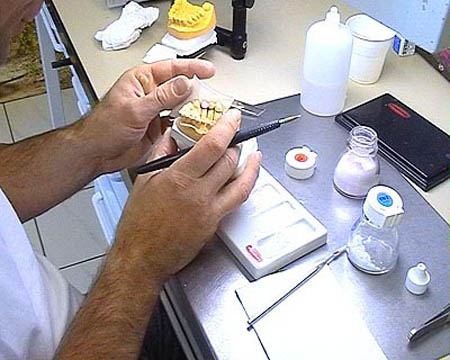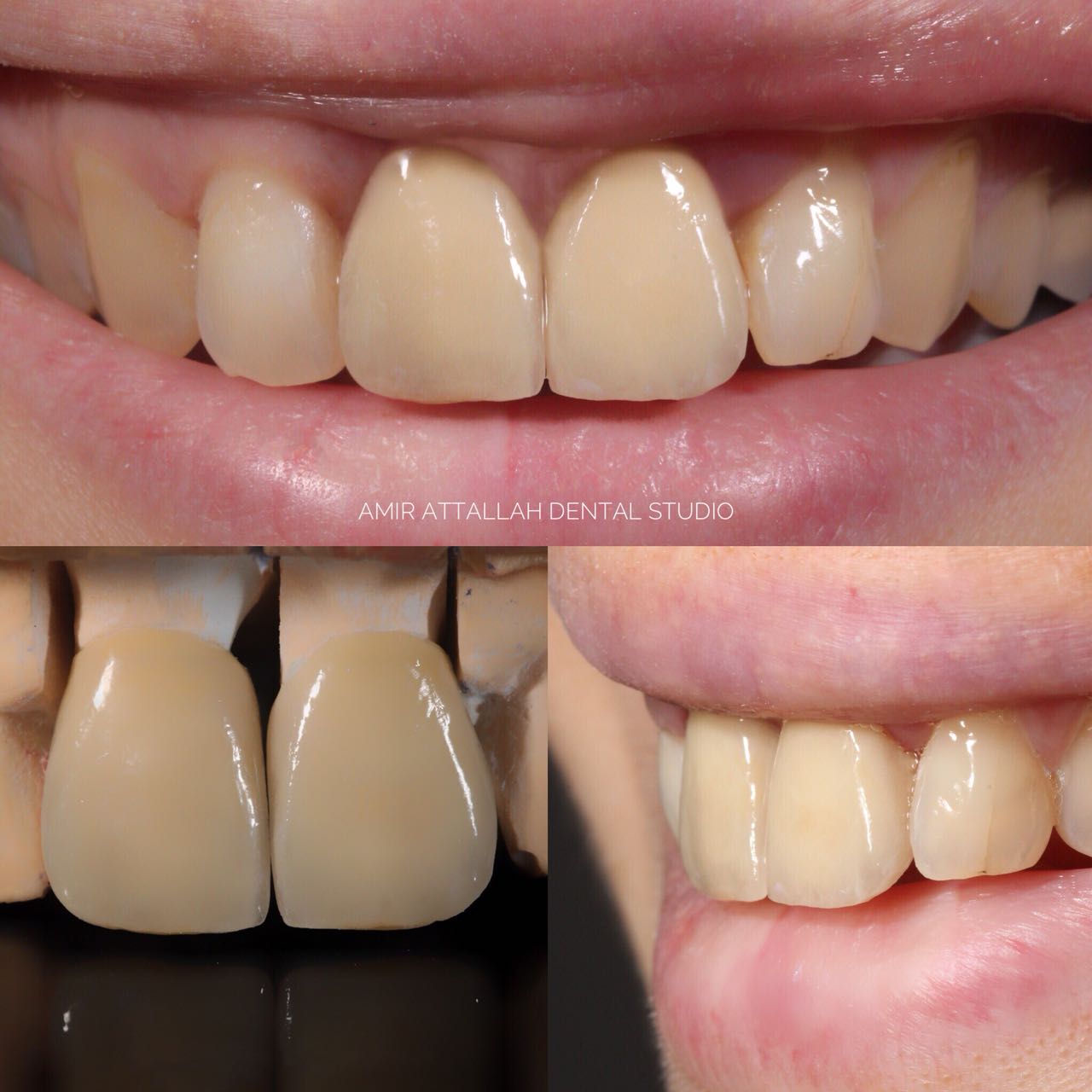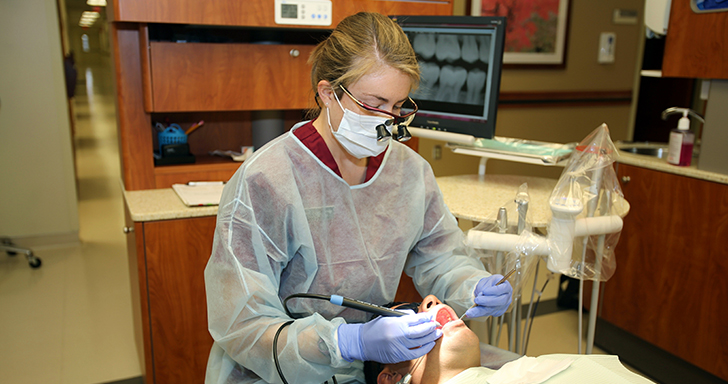|
Dental Technician
A dental technologist (dental laboratory technician) is a member of the dental team who, upon prescription from a dental clinician, constructs custom-made restorative and dental appliances. There are four major disciplines within dental technology. These are ''fixed prosthesis'' including crowns, bridges and implants; ''removable prosthesis'', including dentures and removable partial dentures; ''maxillofacial prosthesis'', including ocular prosthesis and craniofacial prosthesis; and ''orthodontics and auxiliaries'', including orthodontic appliances and mouthguards. The dentist communicates with the dental technologist with prescriptions, drawings, and measurements taken from the patient. The most important aspect of this is a dental impression into which the technologist flows a gypsum dental stone to create a replica of the patient's anatomy known as a dental cast. A technologist can then use this cast for the construction of custom appliances. Fixed restorations A fixed ... [...More Info...] [...Related Items...] OR: [Wikipedia] [Google] [Baidu] |
Fixed Prosthodontics
Fixed prosthodontics is the area of prosthodontics focused on permanently attached (fixed) dental prostheses. Such dental restorations, also referred to as indirect restorations, include crowns, bridges (fixed dentures), inlays, onlays, and veneers. Prosthodontists are specialist dentists who have undertaken training recognized by academic institutions in this field. Fixed prosthodontics can be used to restore single or multiple teeth, spanning areas where teeth have been lost. In general, the main advantages of fixed prosthodontics when compared to direct restorations is the superior strength when used in large restorations, and the ability to create an aesthetic looking tooth. As with any dental restoration, principles used to determine the appropriate restoration involves consideration of the materials to be used, extent of tooth destruction, orientation and location of tooth, and condition of neighboring teeth. A good source of information about this subject can be found at ... [...More Info...] [...Related Items...] OR: [Wikipedia] [Google] [Baidu] |
Dental Hygienist
A dental hygienist or oral hygienist is a licensed dental professional, registered with a dental association or regulatory body within their country of practice. Prior to completing clinical and written board examinations, registered dental hygienists must have either an associate's or bachelor's degree in dental hygiene from an accredited college or university. Once registered, hygienists are primary healthcare professionals who work independently of or alongside dentists and other dental professionals to provide full oral health care. They have the training and education that focus on and specialize in the prevention and treatment of many oral diseases. Dental hygienists have a specific scope of clinical procedures they provide to their patients. They assess a patient's condition in order to offer patient-specific preventive and educational services to promote and maintain good oral health. A major role of a dental hygienist is to perform periodontal therapy which includes thing ... [...More Info...] [...Related Items...] OR: [Wikipedia] [Google] [Baidu] |
Dental Therapist
A dental therapist is a member of the dental team who provides preventive and restorative Dentistry, dental care for children and adults. The precise role varies and is dependent on the therapist's education and the various dental regulations and guidelines of each country. A dental therapist is a licensed professional oral health educator; a clinical operator who uses preventive therapeutic care with a group or individual that attends with oral diseases and helps maintain good or better oral health care. History In 1913, Dr Norman Kershaw Cox, Norman K. Cox, the President of the New Zealand Dental Association, proposed a system of school clinics operated by the state and staffed by 'oral hygienists' to address the dental needs of children between the ages of 6 and 14 years. At the time, the idea was considered to be unorthodox, but in 1920, at a special meeting of the New Zealand Dental Association, 16 members voted for the adoption of school dental nurses with 7 opposed to the ... [...More Info...] [...Related Items...] OR: [Wikipedia] [Google] [Baidu] |
Dental Assistant
Dental assistants are members of the dental team. They support a dental operator (such as a dentist or other treating dental auxiliary) in providing more efficient dental treatment. ''Dental assistants'' are distinguished from other groups of dental auxiliaries (such as dental therapists, dental hygienists and dental technicians) by differing training, roles and patient scopes. History The first dental assistant C. Edmund Kells, a pioneering dentist operating from New Orleans, enlisted the first dental assistant. The dental field was initially dominated by males, but after this first addition of a female, it was then acceptable for women to seek dental treatment without their husbands. This led to dental assistants of that era also being known as "Ladies in Attendance". Thanks to the addition of women to dentistry, the profession flourished with more and more women seeking treatment and more patients overall receiving care. The first association It was not until almo ... [...More Info...] [...Related Items...] OR: [Wikipedia] [Google] [Baidu] |
Dental Auxiliary
A dental auxiliary is any oral health practitioner other than a dentist & dental hygienist, including the supporting team assisting in dental treatment. They include dental assistants (known as dental nurses in the United Kingdom and Ireland), dental therapists and oral health therapists, dental technologists, and orthodontic auxiliaries. The role of dental auxiliaries is usually set out in regional dental regulations, defining the treatment that can be performed. Dental assistants Dental assistant help make dental treatment more efficient by assisting the clinician. They hold and pass instruments, retract tissues and apply suction to assist better vision of the operating field. They also mix materials, help maintain dental records, and sterilize instruments and equipment. Some also engage in professional teeth whitening procedures, particularly in The Republic of Ireland where laser teeth whitening is classified as a cosmetic procedure and not dental treatment. This practice us ... [...More Info...] [...Related Items...] OR: [Wikipedia] [Google] [Baidu] |
Dentistry
Dentistry, also known as dental medicine and oral medicine, is the branch of medicine focused on the teeth, gums, and mouth. It consists of the study, diagnosis, prevention, management, and treatment of diseases, disorders, and conditions of the mouth, most commonly focused on dentition (the development and arrangement of teeth) as well as the oral mucosa. Dentistry may also encompass other aspects of the craniofacial complex including the temporomandibular joint. The practitioner is called a dentist. The history of dentistry is almost as ancient as the history of humanity and civilization with the earliest evidence dating from 7000 BC to 5500 BC. Dentistry is thought to have been the first specialization in medicine which have gone on to develop its own accredited degree with its own specializations. Dentistry is often also understood to subsume the now largely defunct medical specialty of stomatology (the study of the mouth and its disorders and diseases) for which reas ... [...More Info...] [...Related Items...] OR: [Wikipedia] [Google] [Baidu] |
Phonetics
Phonetics is a branch of linguistics that studies how humans produce and perceive sounds, or in the case of sign languages, the equivalent aspects of sign. Linguists who specialize in studying the physical properties of speech are phoneticians. The field of phonetics is traditionally divided into three sub-disciplines based on the research questions involved such as how humans plan and execute movements to produce speech (articulatory phonetics), how various movements affect the properties of the resulting sound (acoustic phonetics), or how humans convert sound waves to linguistic information (auditory phonetics). Traditionally, the minimal linguistic unit of phonetics is the phone—a speech sound in a language which differs from the phonological unit of phoneme; the phoneme is an abstract categorization of phones. Phonetics deals with two aspects of human speech: production—the ways humans make sounds—and perception—the way speech is understood. The communicative modali ... [...More Info...] [...Related Items...] OR: [Wikipedia] [Google] [Baidu] |
Swallowing
Swallowing, sometimes called deglutition in scientific contexts, is the process in the human or animal body that allows for a substance to pass from the mouth, to the pharynx, and into the esophagus, while shutting the epiglottis. Swallowing is an important part of eating and drinking. If the process fails and the material (such as food, drink, or medicine) goes through the trachea, then choking or pulmonary aspiration can occur. In the human body the automatic temporary closing of the epiglottis is controlled by the swallowing reflex. The portion of food, drink, or other material that will move through the neck in one swallow is called a bolus. In colloquial English, the term "swallowing" is also used to describe the action of taking in a large mouthful of food without any biting, where the word gulping is more adequate. In humans Swallowing comes so easily to most people that the process rarely prompts much thought. However, from the viewpoints of physiology, of speech� ... [...More Info...] [...Related Items...] OR: [Wikipedia] [Google] [Baidu] |
Chewing
Chewing or mastication is the process by which food is crushed and ground by teeth. It is the first step of digestion, and it increases the surface area of foods to allow a more efficient break down by enzymes. During the mastication process, the food is positioned by the cheek and tongue between the teeth for grinding. The muscles of mastication move the jaws to bring the teeth into intermittent contact, repeatedly occluding and opening. As chewing continues, the food is made softer and warmer, and the enzymes in saliva begin to break down carbohydrates in the food. After chewing, the food (now called a bolus) is swallowed. It enters the esophagus and via peristalsis continues on to the stomach, where the next step of digestion occurs. Increasing the number of chews per bite increases relevant gut hormones. Studies suggest that chewing may decrease self-reported hunger and food intake. Chewing gum has been around for many centuries; there is evidence that northern Europeans ch ... [...More Info...] [...Related Items...] OR: [Wikipedia] [Google] [Baidu] |
Alveolar Process
The alveolar process () or alveolar bone is the thickened ridge of bone that contains the tooth sockets on the jaw bones (in humans, the maxilla and the mandible). The structures are covered by gums as part of the oral cavity. The synonymous terms ''alveolar ridge'' and ''alveolar margin'' are also sometimes used more specifically to refer to the ridges on the inside of the mouth which can be felt with the tongue, either on roof of the mouth between the upper teeth and the hard palate or on the bottom of the mouth behind the lower teeth. Terminology The term ''alveolar'' () ('hollow') refers to the cavities of the tooth sockets, known as dental alveoli. The alveolar process is also called the ''alveolar bone'' or ''alveolar ridge''. The curved portion is referred to as the alveolar arch. The alveolar bone proper, also called bundle bone, directly surrounds the teeth. The term alveolar crest describes the extreme rim of the bone nearest to the crowns of the teeth. The portion of ... [...More Info...] [...Related Items...] OR: [Wikipedia] [Google] [Baidu] |
Mouthguard
A mouthguard is a protective device for the mouth that covers the teeth and gums to prevent and reduce injury to the teeth, arches, lips and gums. An effective mouthguard is like a crash helmet for teeth and jaws. It also prevents the jaws coming together fully, thereby reducing the risk of jaw joint injuries and concussion. A mouthguard is most often used to prevent injury in contact sports, as a treatment for bruxism or TMD, or as part of certain dental procedures, such as tooth bleaching or sleep apnea treatment. Depending on application, it may also be called a mouth protector, mouth piece, gumshield, gumguard, nightguard, occlusal splint, bite splint, or bite plane. The dentists who specialise in sports dentistry fabricate mouthguards. Types Stock or ready made Manufactured in a pre-formed shape in various sizes but with nearly no adjustment to fit the user's mouth. The only adjustment possible is minor trimming with a knife or scissors. Mouth adapted or "boil and bit ... [...More Info...] [...Related Items...] OR: [Wikipedia] [Google] [Baidu] |





.jpg)
